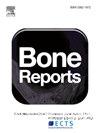Osteosarcopenia as a risk factor for depression: Longitudinal findings from the SHARE study
IF 2.6
Q3 ENDOCRINOLOGY & METABOLISM
引用次数: 0
Abstract
Background
Osteosarcopenia (i.e., the co-existence of osteoporosis and sarcopenia) and depression are highly prevalent among older people. However, the association between osteosarcopenia and depression in older people is largely unknown. Therefore, the present study aims to investigate this possible association in a representative sample of the older adult population in Europe and Israel.
Methods
Osteosarcopenia was defined as the concomitant presence of osteoporosis and sarcopenia; depressive symptoms in the SHARE study were self-reported using the EURO-D scale. The association between the presence of osteosarcopenia at baseline in people free from depression and incident depression during 12 years of follow-up was analyzed using a Cox's regression analysis, adjusting for several baseline covariates.
Results
16,452 participants were included (mean age 63.7, SD 9.6; females 50.6 %). During the follow-up period, 5056 participants (31.1 % of the initial population) became depressed. People affected by osteosarcopenia became depressed in more than half of the cases compared to a quarter of controls. After adjusting for several potential baseline confounding variables, only sarcopenia (HR, hazard ratio = 1.17; 95 % CI, confidence intervals 1.04–1.32; p = 0.009) and osteosarcopenia (HR = 1.27; CI 95 % 1.12–1.58; p = 0.003) were significantly associated with a higher risk of depression.
Limitations
Definition of sarcopenia using an anthropometric equation; definition of depression using the EURO-D scale.
Conclusions
The present study identified a significant association between osteosarcopenia and depression over 12 years of follow-up, mainly driven by sarcopenia. If future research confirms the present findings, it may then be prudent to target those with osteosarcopenia to aid in the prevention of onset depression.
骨骼肌减少症是抑郁症的危险因素:SHARE研究的纵向发现
背景:骨骼肌减少症(即骨质疏松症和骨骼肌减少症并存)和抑郁症在老年人中非常普遍。然而,骨骼肌减少症与老年人抑郁症之间的关系在很大程度上是未知的。因此,本研究的目的是在欧洲和以色列老年人口的代表性样本中调查这种可能的关联。方法将骨骼肌减少症定义为骨质疏松症和骨骼肌减少症并存;SHARE研究中的抑郁症状采用EURO-D量表自我报告。在12年的随访中,无抑郁症患者基线时骨骼肌减少症的存在与事件性抑郁症之间的关系通过Cox回归分析进行了分析,调整了几个基线协变量。结果共纳入16452名参与者(平均年龄63.7岁,SD 9.6;女性50.6%)。在随访期间,5056名参与者(占初始人群的31.1%)变得抑郁。受骨骼肌减少症影响的患者中有超过一半的人患上了抑郁症,而对照组中只有四分之一的人患上了抑郁症。在调整了几个潜在的基线混杂变量后,只有肌肉减少症(HR,风险比= 1.17;95% CI,置信区间1.04 ~ 1.32;p = 0.009)和骨骼肌减少症(HR = 1.27;Ci 95% 1.12-1.58;P = 0.003)与较高的抑郁风险显著相关。局限性使用人体测量方程定义肌肉减少症;用EURO-D量表来定义抑郁症。结论:本研究在12年的随访中发现骨骼肌减少症与抑郁症之间存在显著关联,主要由骨骼肌减少症引起。如果未来的研究证实了目前的发现,那么针对骨质减少症患者来帮助预防抑郁症的发作可能是谨慎的。
本文章由计算机程序翻译,如有差异,请以英文原文为准。
求助全文
约1分钟内获得全文
求助全文
来源期刊

Bone Reports
Medicine-Orthopedics and Sports Medicine
CiteScore
4.30
自引率
4.00%
发文量
444
审稿时长
57 days
期刊介绍:
Bone Reports is an interdisciplinary forum for the rapid publication of Original Research Articles and Case Reports across basic, translational and clinical aspects of bone and mineral metabolism. The journal publishes papers that are scientifically sound, with the peer review process focused principally on verifying sound methodologies, and correct data analysis and interpretation. We welcome studies either replicating or failing to replicate a previous study, and null findings. We fulfil a critical and current need to enhance research by publishing reproducibility studies and null findings.
 求助内容:
求助内容: 应助结果提醒方式:
应助结果提醒方式:


